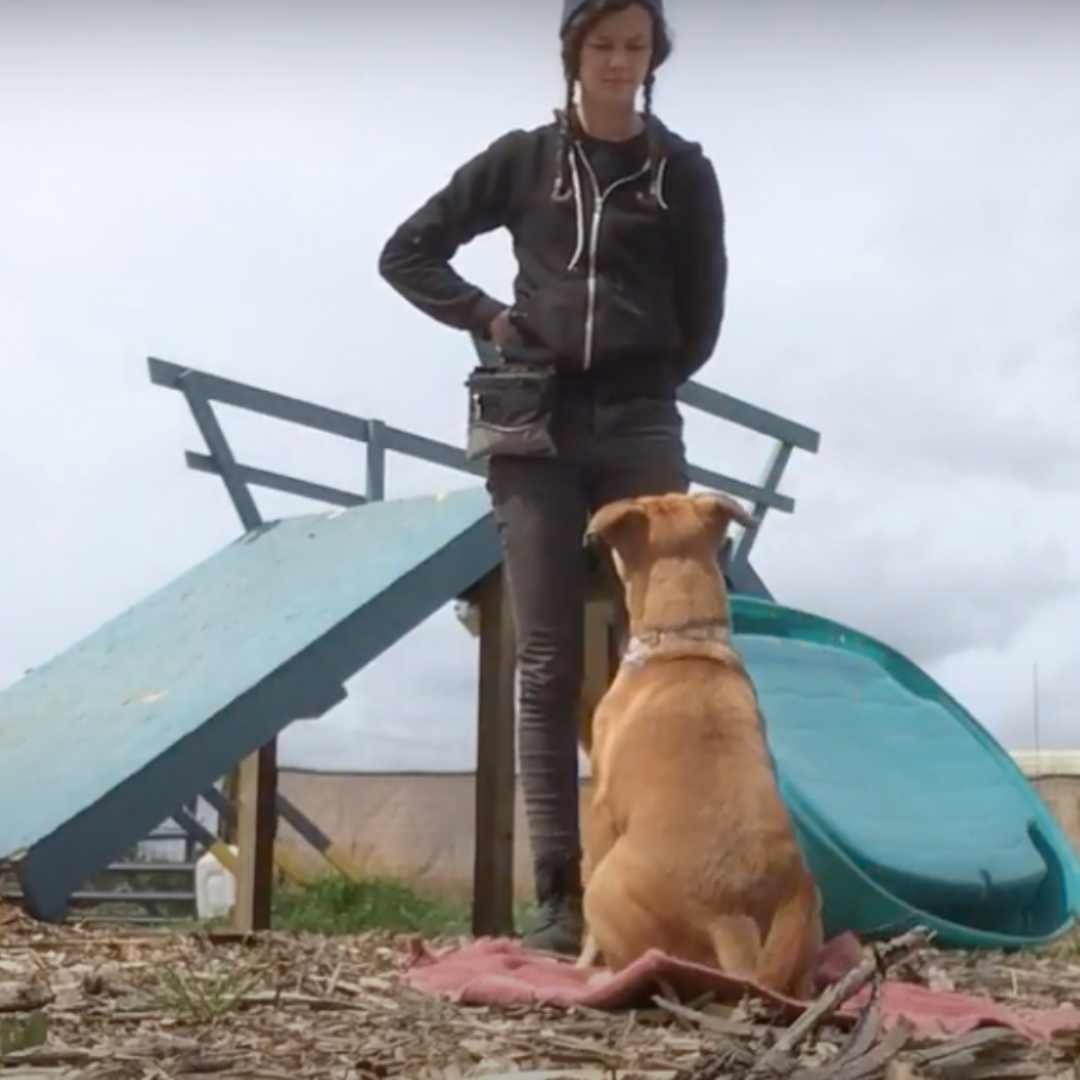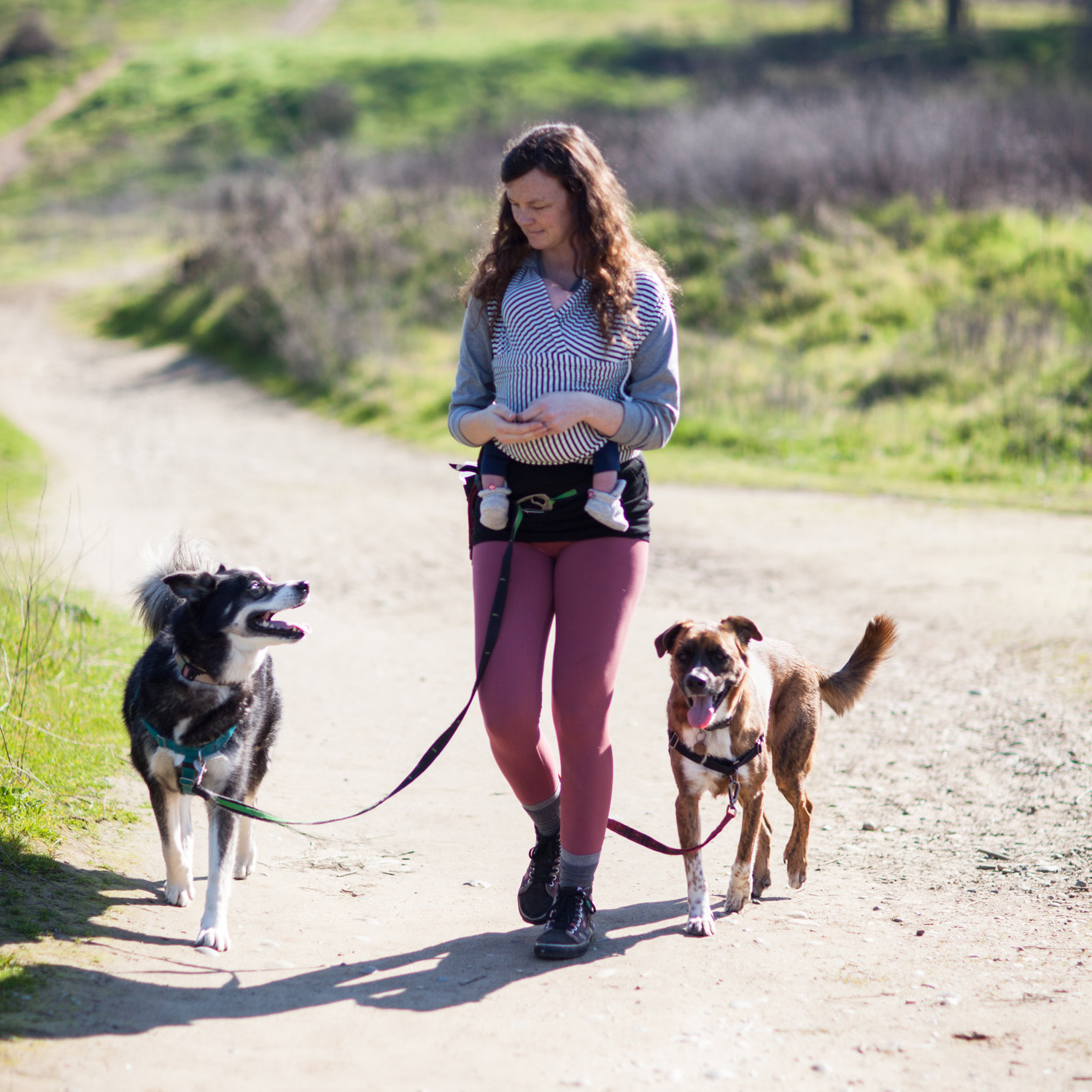Ever dream of having a magic wand you could use anytime you wanted your dog to quietly lie down in a happy, security-blanket kind of place while you had a conference call, fed your kids dinner, or entertained friends?
Well, that's essentially what teaching your dog "go to bed" (or mat or even a carpet square) is all about.
To teach your pup this super versatile dog behavior, we'll start training by using shaping. Shaping means that you're going to capture your dog's "good" behaviors and then gradually shape them into more complex or specific behaviors, like being in a place.
What does that actually mean?
Dog shaping is a dog training technique that uses small baby steps to teach a new behavior without prompting or correcting. It's sometimes called "free shaping" because of the natural, collaborative effort between you and your dog. Shaping is a powerful training tool in dog training you can use to help your dog learn just about anything.
As you train in tandem with your dog, you're shaping success. Every positive trainer will confirm the added bonus for both of you - it's so much fun strengthening your unspoken communications together in the process!
Okay, but tell me more...
To start your shaping session, have an idea in your head of what the "finished" final behavior you want is going to look like. Picture what it would be like if you could say "go to bed" or whatever verbal cue works for you both whenever you would like your dog to calmly retire to a specific spot while you have dinner or enjoy guests, etc., and your well-behaved dog happily rests quietly there for as long as you'd like.
Your Dog's Plan
Stop! Don't read this long article. Instead, get everything you need to know, including all advice on Go To Mat, in a customizable step-by-step plan for your dog created by our community of certified trainers and nutritionists.
Tip 1: Decide the desired behavior you want and break it into easily achievable steps
We'll dive into all 10 steps to successfully shape "go to bed" below but the first baby step in your shaping program may just be your dog looking at the object, whether that's a bed or mat. That's it! Just a glance is a win in our book. Then maybe your dog moves toward the bed or mat, or touches it. Another win! Shaping is like playing a game of "hotter/colder" with our dogs, but in this case, we don't need to bother telling them "colder," because by focusing on and rewarding the "hotter," they'll begin to put the pieces of the puzzle together and learn to offer behaviors we want.
Try this
Before learning shaping make sure your dog understands clicker training (you could also use a verbal marker instead of a clicker, but the click is a more precise tool to signal a reward is coming). And have a clicker, high value treats aka something your dog considers a big reward, and a mat, dog bed, blanket, towel, etc. to serve as the shaping station.
Tip 2: Listen to your dog and take breaks when needed
Move up or down the steps in the shaping training plan below according to how well your pup does as you train. Some dogs may skip steps for example, which is great. It's also okay to go back a step or two if you find your rate of reinforcement is lagging or your dog is getting stuck. And it's also okay to take a break! If you feel that your dog is struggling with this behavior or getting frustrated, have some play time and come back to training when you're both ready.
Remember, we are setting our dogs up for success, so keep your training session fun and positive. Think of it as a shaping game and you'll both enjoy the journey to your goal behavior! Split up these instructions so you can keep sessions nice and short (no more than 2-5 minutes) and end on a high note with something fun like a belly rub or some playtime.
Go To Mat
Interested in Go To Mat? Follow topics you're interested in to customize your dog’s step-by-step plan so it's most helpful and tailored to your dog when you're ready to get started.
Tip 3: Set up your space (+ you and your dog!) for shaping success
It's important to set up the training space so the desired dog behavior is likely to occur. You'll want to place your dog's bed, mat or crate in the place where you would like your dog to go. The more often your dog goes there for you, the faster he/she will learn!
What does that actually mean?
This means setting the target behavior up to happen in a quiet, clutter-free space where there isn't a lot of interesting stuff lying around that may seem more intriguing to our dogs than the training process.
Think about where you're placing the mat - most dogs are interested in orienting to their person, so by placing the mat between your dog and you, you're increasing the probability that your dog will move toward it.
Tell me more
Also, think about how you present your reinforcer (high-value treat) - by gently tossing the treat away from you past the mat, you set your dog up for another opportunity to move back toward you after gobbling up the treat.
Keep in mind when taking a break that your dog may start at a slightly different place in the training plan once you resume. That's normal and totally fine. Your dog will likely move through the steps more quickly the subsequent times.
Try this
Be ready to click and treat before you place the mat or bed on the ground! We want to catch that very first "hey, what's that" moment to lead our dog in the right direction with that first small step toward the final behavior.
And now you're ready for the shaping training plan! Here are...
10 small steps to start shaping a solid "go to bed"
- Place the mat on the ground, as described above. Click your clicker the moment your dog moves toward or even looks at the mat (remember, good timing on your part matters!). Toss the treat away to reward your dog (see video below). Each of these steps will be followed by this treat tossing pattern.
- Click for movement toward the mat. Toss the treat away to reward your dog.
- Click for any touching of the mat - even a nose or paw. Toss the treat away to reward your dog.
- Click for one paw on the mat. Toss the treat away to reward your dog.
- After a few clicks for one paw, delay the click slightly and see if you get two paws on the bed or mat. (You're working patiently to gradually build to four feet on the mat.) Toss the treat away to reward your dog.
- Click for three or four paws on the bed or mat. This is a great place to "jackpot" (give your dog several treats in a row) and throw a big party. You're marking success for both of you at shaping a behavior! This is also a great place to take a break, if you haven't already.
- Next we're waiting for the moment your dog offers a sit on the mat or bed. This frequently happens by delaying the click slightly. If your pup shows no inclination to sit, you can skip this step.
- After sitting on the mat or bed, many dogs will offer a down if the click is delayed. If so, great, click this and treat toss! If not, you can cue your dog to lie down once he/she is on the mat (either sitting or standing, depending on what your dog is more likely to offer) and then treat toss.
- Begin fading the cue for "down." Either make the cue less perceptible through several repetitions (quieter if it's a verbal cue, or smaller movement if it's a visual cue) or just try delaying the cue and see if your dog goes into the down position on his or her own. Dogs are great at making the connection between two behaviors that are often done in sequence (this is called chaining).
- Once the behavior of going to the mat and lying down (without the additional cue for the down) is consistent (ie you'd be willing to bet $20 that your dog will do the whole sequence on the next rep), you are ready to add a cue. This is the thing you will say to your dog when you want him or her to go to the mat and lie down, so pick something that feels natural. I use "On your mat" which is a little long/clunky, but works for me. Other options: Go to bed, go to place, station, etc. You are going to say this after your dog has eaten the treat but before returning to the mat for their next rep. This will take practice before it becomes a learned cue! Do not expect your dog to understand the cue after one session.
Manners
Need more advice? Browse all guides in the Manners Channel on topics like Go To Mat, Food Manners, Party Manners, Stay, Public Manners, Travel Manners, and Basic Manners - created by our community of certified experts for you and your dog.
There you have it - your shaping plan: the 10 initial steps to teaching this new behavior in small increments to your final goal.
Learn the magic of dog shaping and teach your pup the versatile behavior of 'go to bed.'
Choose how you'd like to view this guide's video.

Next up in the Manners Channel on Dogly
Now you know how to train purposefully with your dog, reward your dog for offering the right behavior, and how to use the dog-shaping training method to teach your dog to "go to bed/mat." I hope you found this guide helpful!
Before teaching you how to train your dog to go to bed/mat for long periods of time, at a distance, or with distractions - let's learn from some common questions and answers here.
If you ever have questions, feel free to ask them in the Community discussion in the Manners Channel or I'm happy to help you 1-1 if you would like more personal training guidance.

